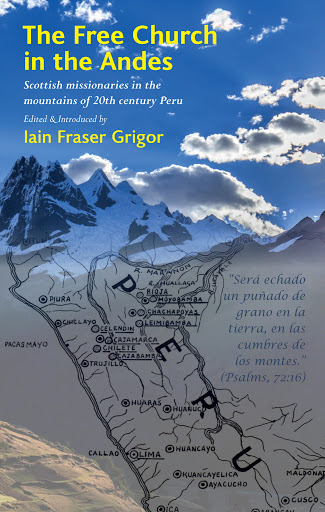This book gives a fascinating insight into aspects of Free Church missionary endeavour in the Peruvian Andes in the 20th century. It is a story of arduous journeys to incredibly remote places at high altitudes, medical missions and church planting against hostility from Roman Catholic clergy, and of some remarkable characters who deserve not to be forgotten by history, and especially not by the Free Church.
The book opens with an introductory chapter by the editor giving an overview of the missionary effort in the Free Church from its founding in 1843 to the establishment of mission work in the Andes in the 1920’s, and on to the present day with the prospect of celebrating the centenary of that work in 2021. As one who was not brought up in the Free Church I found this to be an excellent opening to the subject. It not only introduced key characters and places, but also highlighted issues that faced the Free Church of how to establish church structures and allow the Peruvian church to become truly independent. Names such as Annie Soper, J. Calvin MacKay and Dr Harold Lindsay, and places such as Cajamarca, Celendin and Moyobamba may be well-known to older church members. However, they are new to me, and probably also to the younger generation coming through in the Church.
Due to a lack of sources for a traditional history, each of the subsequent chapters is an extract from a missionary journal, a visitors’ report, or personal reminiscences from more recent missionaries of the ‘70s and ‘80s. All of the writers are engaging and succeed in painting vivid pictures of the cultural setting and the challenges of missionary living in the Andes. I will highlight two contributions as illustrative of the whole: first, the account of Dr Kenneth MacKay’s trip from Glasgow to Moyobamba in 1926 via train, steamship, coastal steamer, train, horse, mule and on foot. It was an epic journey and demonstrated the commitment required to take the gospel to a new field in those days. Secondly, Ronnie Christie’s account of his time in the 1970’s where he shows the progress of the work including conventions, camps and a bookshop in Cajamarca. Travel could still be extremely difficult, culminating in a 35 mile walk to find a helicopter to rescue two people seriously injured following a major earthquake.
The book left me with many unanswered questions and wanting to know more. Who were the first converts and the first congregation? Why were Peruvian pastors not allowed to administer the sacraments in the late ‘60s and early ‘70s? (Could they really be considered pastors in those circumstances?). Iain Fraser Grigor suggests in his afterword that a lot of the gaps in knowledge could be filled in with further research, perhaps for a doctoral thesis. I, for one, would support such research being carried out at the ETS Centre for Mission. The work in Peru was a major achievement for a small denomination and we would do well to remember, teach and celebrate it.
The book opens by stating that by the time of the death of Thomas Chalmers in 1847 the Free Church was operating possibly the largest missionary endeavour in the world. It did this while also organising 700 churches and 650 schools at home in a four-year period. Today we think that seeking to plant 30 churches by the end of the decade is ambitious, while the denomination’s international mission work is a fraction of what it was, even in the 1980s. Perhaps it is time that we meditated upon our past in order to get a larger vision for the future. This book is a useful starting point and well worth a read.
This book is available to purchase from Lumphanan Press.
Duncan MacPherson, North Harris Free Church

